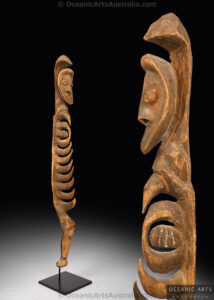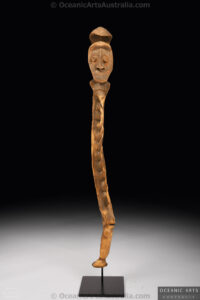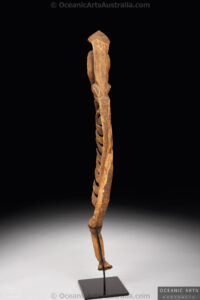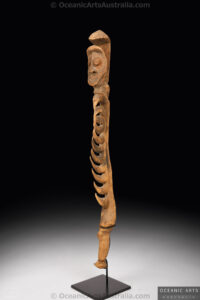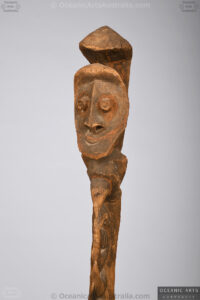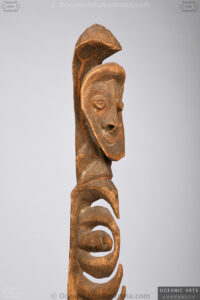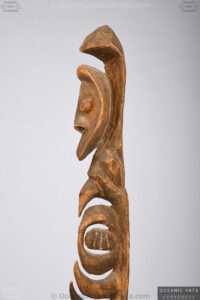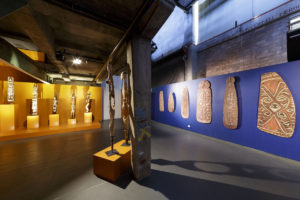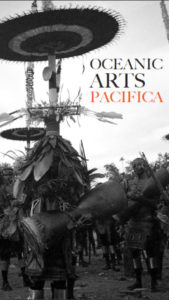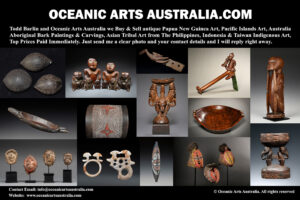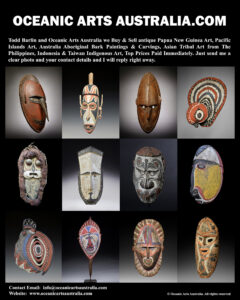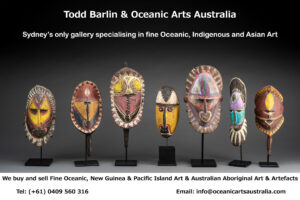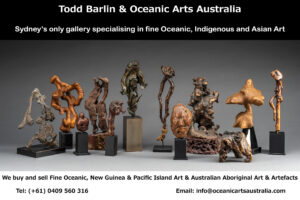A Superb Old New Guinea Karawari River Aripa Cult Figure East Sepik River Province Papua New Guinea
| Collection No. | TB-2746 |
|---|---|
| Size | Height 110cm |
A Superb Old New Guinea Karawari River Aripa Cult Figure East Sepik River Province Papua New Guinea
This fine old Cult Figure called Aripa is from the upper Karawari River area in the East Sepik River Province of Papua New Guinea.
These superb artworks from the Karawari River area are some of the finest artworks from all of Papua New Guinea and even in ” World Art ” they are very strong examples of human creativity and spirituality.
The Karawari River is one of the numerous tributaries of the great Sepik River, which drains into the north coast of New Guinea. In a series of caves and rock shelters along the upper reaches of the Karawari, the Ewa people kept a remarkable series of wood carvings like this figure that were created and used by Ewa men during their lifetimes, the carvings were kept after their owners’ deaths. Preserved in the caves for generations, some of the carvings are between 200 and 400 years old, making them some of the oldest surviving examples of wood sculpture from New Guinea.
This figure is not in the ” ancient category ” of being 200- 400 years old as the ancient Karawari Cave Figures, it is more likely late 19th Century to early 20th Century but definitely a used figure. It has the correct old dry patina just like the ancient Karawari Figures. Nowadays you can see many fake Karawari Figures for sale they are brown wood & heavily weathered which is the opposite of how an old genuine Karawari Figure should look.
There are numerous variations in these figures, reflecting the individual visions of the sculptors who created them but the carvings are of three basic types. The first consists of thin, silhouette-like one-legged male figures like my example seemingly made to be viewed in profile. The second is plank-like female figures shown in frontal view, and the third are small wood heads mounted on spikes.
The Ewa practiced agriculture but they were also heavily dependent on hunting for their livelihood. The rich rain forests that surrounded them provided a variety of game, including wild pigs, tree kangaroos, and cassowaries. The one-legged male figures, called aripa, played a vital part in hunting magic. Representing individual helping spirits, each aripa served as a means by which an Ewa man could maintain contact with, and receive aid from, his helping spirit to bring him success in hunting.
The carvings from the Karawari caves first came to the attention of the wider world about fifty years ago when the Ewa, having changed or abandoned their former beliefs, began to bring the carvings out of their caves and offer them for sale to Westerners. As a result, today these remarkable works of art from the Karawari can be seen in museums and private collections throughout the world.
Provenance: Old USA Collection: The Todd Barlin Collection of New Guinea Art and Oceanic Art.
I first went to Papua New Guinea in 1985 for an adventure & what I found was that I really enjoyed being with the people of New Guinea, over the next 38 years I spent extensive time spent collecting and documenting traditional art & ceremonies in remote areas of Papua New Guinea & West Papua, The Solomon Islands & Vanuatu & the other Pacific Islands countries. During these travels, I made major collections of New Guinea & Oceanic Art for major Museums and Public Art Galleries
I was honoured by being in the prestigious Louvre Museum Magazine for the collections I made for The Museum of African & Oceanic Art Paris in1996 (now the Musee Quai Branly) for the exhibition “Asmat et Mimika d’ Irian Jaya April 1996 At THE MUSEE NATIONAL des ARTS D’AFRIQUE et d’ OCEANIE, Paris
See all of the photos in my new EXHIBITIONS GALLERY https://www.oceanicartsaustralia.com/about/exhibition-and-publications/
and there is the link to the article in the prestigious Louvre Magazine 1996 https://www.oceanicartsaustralia.com/art-for-sale/louvre-magazine-june-1996-review-of-exhibition-asmat-et-mimika-d-irian-jaya-april-1996-at-the-musee-national-des-arts-dafrique-et-d-oceanie-paris/
I have artwork for Museums & Art Galleries but also for collectors at every stage of their collecting. I want to encourage people to explore the fine art of New Guinea & West Papua and the Pacific Islands and to be able to see and touch the artworks in a relaxed and friendly manner in my Sydney Gallery. I would like to invite you to visit my gallery and see the artworks in person and also look at my website www.oceanicartsaustralia.com where there are many Galleries & Sub Galleries to explore.
My Gallery of nearly 40 years is the last physical gallery in Sydney that specialises in New Guinea & Oceanic Art. Sydney is just a couple hours’ flight to New Guinea & the Pacific Islands where all of these amazing artworks came from, Australia’s closest neighbours.
INQUIRE HERE
To see many more rare items and the finest masterpieces, please make an appointment with us to visit the gallery.

